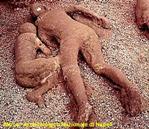Pyroclastics - Pumice and Ash
 Just as dissolved gas bubbles out of a fizzy drink when it is opened, so gas dissolved in magma escapes when pressure is released as it reaches the surface.
Just as dissolved gas bubbles out of a fizzy drink when it is opened, so gas dissolved in magma escapes when pressure is released as it reaches the surface. If the magma contains a lot of dissolved gases, then it will tend to “froth up” as the pressure is released during an eruption. This is how pumice (right) is formed.
The most powerful volcanic eruptions occur when magma starts to froth up as it erupts, forcing pumice out of the vent under pressure, just as happens when you shake up a bottle of fizzy drink and open it!
 Exploding gas bubbles shatter the pumice into tiny fragments which we call volcanic ash. Ash clouds are driven high into the atmosphere by the force of these eruptions; the finest particles may spread for hundreds of miles before falling back to Earth.
Exploding gas bubbles shatter the pumice into tiny fragments which we call volcanic ash. Ash clouds are driven high into the atmosphere by the force of these eruptions; the finest particles may spread for hundreds of miles before falling back to Earth.This type of eruption took place at Vesuvius in Italy in 79 AD. Towards the end of the eruption, the column of gas and ash started to collapse and form pyroclastic flows.
 These mixtures of super-hot gas and choking ash can flow downhill at speeds of over 100 km/h, killing everything in their paths.
These mixtures of super-hot gas and choking ash can flow downhill at speeds of over 100 km/h, killing everything in their paths. Visit the Wikipedia website on Pompeii.

